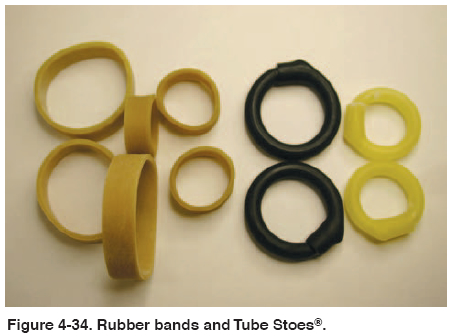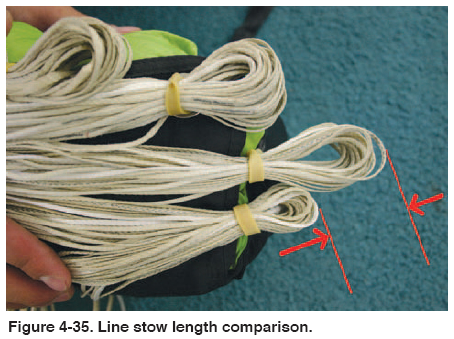Chapter 4
BRIDLE LENGTH
The length of the bridle has an effect primarily on the
deployment of the main pilot chute. The bridle must be
long enough to place the deployed pilot chute past the
turbulence caused by the parachutist. If the bridle is
too short, the pilot chute will stay in the parachutist’s
burble. The length of the bridle from the locking pin to
the pilot chute averages around 7 feet. Recent years
have seen the growth of the use of the “Birdman” flying
suits. Because of the increased surface area and the
decreased free fall speeds, the use of a longer bridle
has become common, with a 9-foot length working
well. Along with the longer bridle, containers have
been modified to allow the bottom to open fully and
the main bag to be extracted rearward towards the feet
due to the more horizontal trajectory of the parachutist.
RUBBER BANDS
The rubber stow bands play an important part of the
deployment sequence, and serve two important functions.
First, they hold the mouth of the deployment bag
closed and prevent premature deployment of the main
canopy. Secondly, they hold the line stows securely to
allow a clean, orderly deployment of the lines. With
the advent of smaller diameter lines, such as 550
Spectra® and HMA®, smaller diameter rubber bands
have been developed to properly secure these lines. If
the smaller rubber bands are not available, many parachutists
double stow the larger rubber bands around the
small lines. There are other products such as Tube
Stoes®, which are designed to replace rubber bands
and last longer. Figure 4-34 shows the various rubber
bands and Tube Stoes®. In addition to the correct rubber
bands, the length of the line stows is important as
well. In the past, 1" stows were common, but today, 3"
stows are recommended by several manufacturers.
Figure 4-35 shows the comparison between the two
lengths. The main point to remember is that the lines
must be stowed neatly and securely.
 
ASSEMBLY OF THE MAIN CANOPY TO THE HARNESS AND CONTAINER
The rigger should be familiar with the various types of
canopy releases currently in use. In skydiving, the
most common release is the 3-ring release system. It
was originally developed in 1976 for skydiving, but
has since become the dominant release system for
intentional jumping, both civilian and military.
Riggers must be familiar with the assembly of the 3-ring
release since they may have to connect new canopies to
the harness and container, or have to disconnect the main
canopy to untangle it after landing. Figures 4-36 thru
4-43 show the correct assembly sequence.
 
 
 
 
The rigger must also be able to inspect the 3-ring
release to determine any wear. In particular, the following
areas need to be inspected:
• Harness 3-ring attachment. [Figure 4-44] Check for
wear on the webbing and any damage to the ring or
chipping of the plating.

• Main riser rings. Check for webbing wear, hardware
plating, grommet wear, and locking loop wear/damage.
[Figure 4-45]

• Release housings. Check for damage to terminal endings
and grommet. Check for obstructions or dirt in
housing. Check security of the housing tacking to the
harness. [Figure 4-46]

• 3-ring release handle. Check the cable for cleanliness
and cracks, and ensure that the cable ends are
sealed; inspect the Velcro® on the handle.
[Figure 4-47]

Any questions concerning the particular harness 3-ring
installation should be referred to the harness and container
manufacturer.
| 
